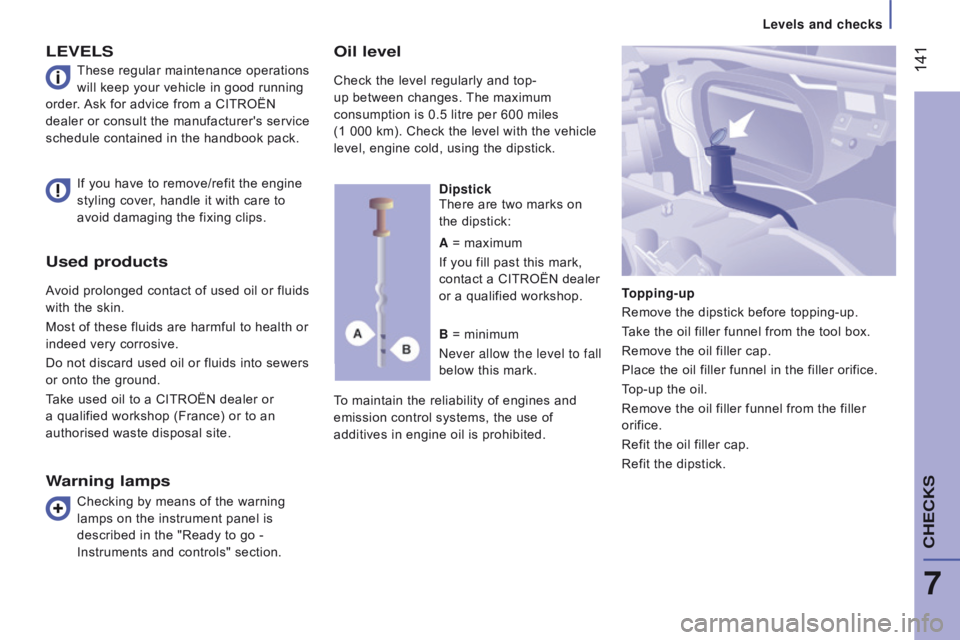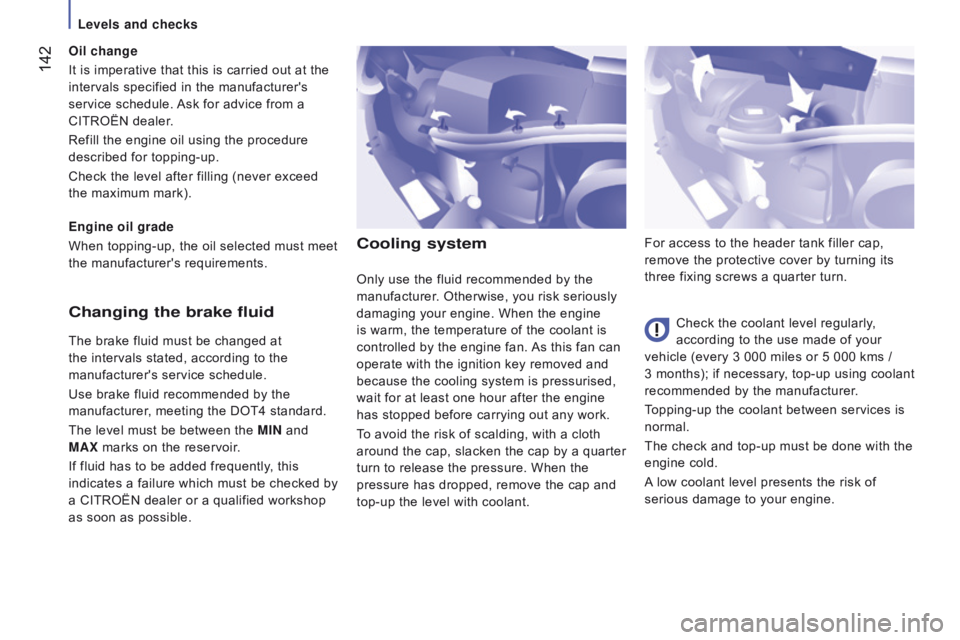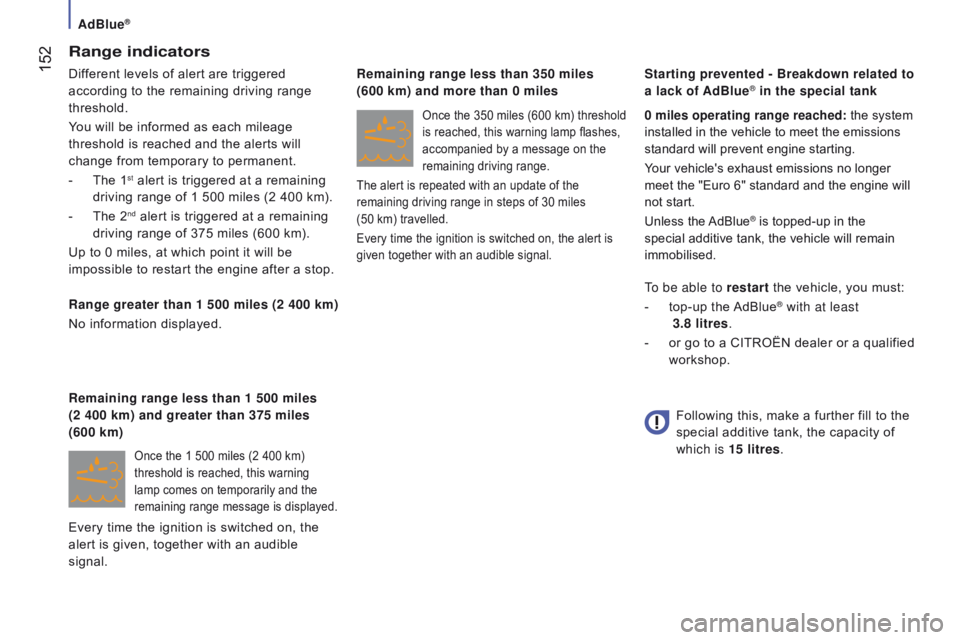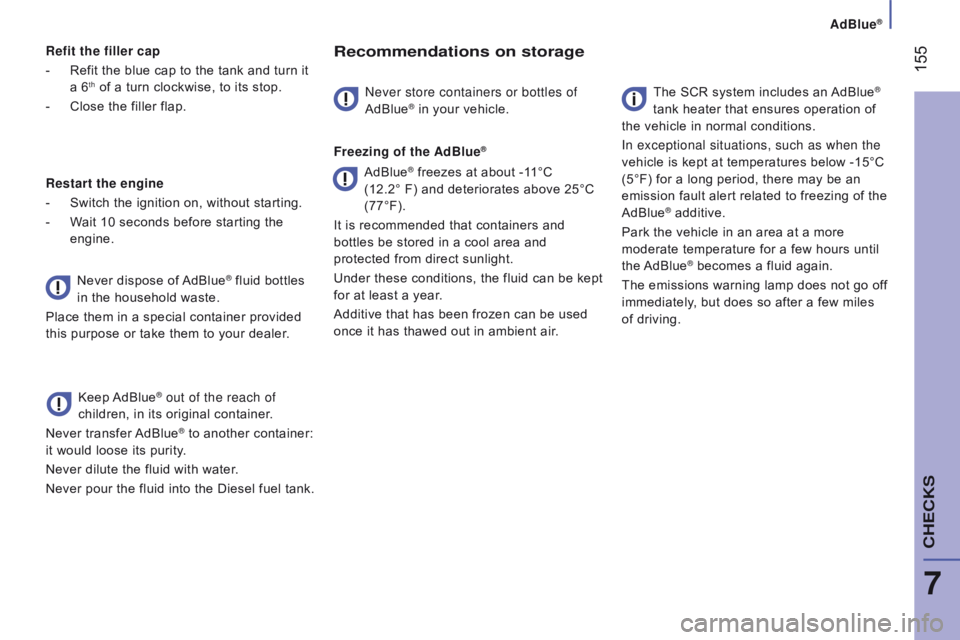Mile to km CITROEN RELAY 2017 Handbook (in English)
[x] Cancel search | Manufacturer: CITROEN, Model Year: 2017, Model line: RELAY, Model: CITROEN RELAY 2017Pages: 292, PDF Size: 9.04 MB
Page 143 of 292

141
used products
Avoid prolonged contact of used oil or fluids
with the skin.
Most of these fluids are harmful to health or
indeed very corrosive.
Do not discard used oil or fluids into sewers
or onto the ground.
Take used oil to a CITROËN dealer or
a qualified workshop (France) or to an
authorised waste disposal site.
LEVELS
To maintain the reliability of engines and
emission control systems, the use of
additives in engine oil is prohibited.
If you have to remove/refit the engine
styling cover, handle it with care to
avoid damaging the fixing clips.
d
ipstick
There are two marks on
the dipstick:
topping-up
Remove the dipstick before topping-up.
T
ake the oil filler funnel from the tool box.
Remove the oil filler cap.
Place the oil filler funnel in the filler orifice.
Top-up the oil.
Remove the oil filler funnel from the filler
orifice.
Refit the oil filler cap.
Refit the dipstick.
A
= maximum
If you fill past this mark,
contact a CITROËN dealer
or a qualified workshop.
B = minimum
Never allow the level to fall
below this mark.
Warning lamps
These regular maintenance operations
will keep your vehicle in good running
order. Ask for advice from a CITROËN
dealer or consult the manufacturer's service
schedule contained in the handbook pack.
Checking by means of the warning
lamps on the instrument panel is
described in the "Ready to go -
Instruments and controls" section.
Oil level
Check the level regularly and top-
up between changes. The maximum
consumption is 0.5 litre per 600 miles
(1 000 km). Check the level with the vehicle
level, engine cold, using the dipstick.
7
cHEcKS
Levels and checks
Page 144 of 292

142
cooling system
Check the coolant level regularly,
according to the use made of your
vehicle (every 3 000 miles or 5 000 kms
/
3
months);
if necessary, top-up using coolant
recommended by the manufacturer.
Topping-up the coolant between services is
normal.
The check and top-up must be done with the
engine cold.
A low coolant level presents the risk of
serious damage to your engine. For access to the header tank filler cap,
remove the protective cover by turning its
three fixing screws a quarter turn.
Only use the fluid recommended by the
manufacturer. Otherwise, you risk seriously
damaging your engine. When the engine
is warm, the temperature of the coolant is
controlled by the engine fan. As this fan can
operate with the ignition key removed and
because the cooling system is pressurised,
wait for at least one hour after the engine
has stopped before carrying out any work.
To avoid the risk of scalding, with a cloth
around the cap, slacken the cap by a quarter
turn to release the pressure. When the
pressure has dropped, remove the cap and
top-up the level with coolant.changing the brake fluid
The brake fluid must be changed at
the intervals stated, according to the
manufacturer's service schedule.
Use brake fluid recommended by the
manufacturer, meeting the DOT4 standard.
The level must be between the MI
n and
MA
x marks on the reservoir.
If fluid has to be added frequently, this
indicates a failure which must be checked by
a CITROËN dealer or a qualified workshop
as soon as possible. Engine oil grade
When topping-up, the oil selected must meet
the manufacturer's requirements. Oil change
It is imperative that this is carried out at the
intervals specified in the manufacturer's
service schedule. Ask for advice from a
CITROËN dealer.
Refill the engine oil using the procedure
described for topping-up.
Check the level after filling (never exceed
the maximum mark).
Levels and checks
Page 154 of 292

152
range indicators
Different levels of alert are triggered
according to the remaining driving range
threshold.
You will be informed as each mileage
threshold is reached and the alerts will
change from temporary to permanent.
-
The 1st alert is triggered at a remaining
driving range of 1 500 miles (2 400 km).
-
The 2nd alert is triggered at a remaining
driving range of 375 miles (600 km).
Up to 0 miles, at which point it will be
impossible to restart the engine after a stop.
r
ange greater than 1 500 miles (2 400 km)
No information displayed.
Once the 1 500 miles (2 400 km)
threshold is reached, this warning
lamp comes on temporarily and the
remaining range message is displayed.
remaining range less than 1 500 miles
(2 400 km) and greater than 375 miles
(600 km)
Once the 350 miles (600 km) threshold
is reached, this warning lamp flashes,
accompanied by a message on the
remaining driving range.
The alert is repeated with an update of the
remaining driving range in steps of 30 miles
(50 km) travelled.
Every time the ignition is switched on, the alert is
given together with an audible signal.0 miles operating range reached: the system
installed in the vehicle to meet the emissions
standard will prevent engine starting.
Your vehicle's exhaust emissions no longer
meet the "Euro 6" standard and the engine will
not start.
Unless the AdBlue
® is topped-up in the
special additive tank, the vehicle will remain
immobilised.
To be able to restart the vehicle, you must:
-
top-up the
AdBlue® with at least
3.8 litres.
-
or
go to a CITROËN dealer or a qualified
workshop.
r
emaining range less than 350 miles
(600 km) and more than 0 miles Starting prevented - Breakdown related to
a lack of AdBlue
®
in the special tank
Following this, make a further fill to the
special additive tank, the capacity of
which is 15 litres.
Every time the ignition is switched on, the
alert is given, together with an audible
signal.
AdBlue®
Page 155 of 292

153
Fault with the Scr system
The diagnostic warning lamp
comes on.
Every time the ignition is
switched on, the emissions fault
is confirmed by an audible signal and a
message.
If it is a temporary fault, the alert disappears
as soon as the exhaust emissions return to
the levels required by the standard. Fault confirmed
In addition to the previous signals, the
remaining range allowed will be displayed in
miles (kilometres) in the instrument panel.
The alert will be repeated every 30 seconds
with an update of the driving range.
Go to a CITROËN dealer or a qualified
workshop as soon as possible.
You risk not being able to start the engine.
Starting prevented, having covered the
250 miles (400 km)
d
etection
At each attempt at starting,
the alert is activated and the
message on starting prevention is
displayed.
On the other hand, if the warning lamp
is still on after 30 miles (50 km) of
driving, the fault is confirmed.
An engine start prevention system
will be activated automatically after
250
miles (400 km) travelled following this
confirmation.
Go to a CITROËN dealer or a qualified
workshop.
AdBlue®
7
cHEcKS
Page 157 of 292

155
refit the filler cap
-
Refit the blue cap to the tank and turn it
a 6
th of a turn clockwise, to its stop.
-
Close the filler flap.
r
estart the engine
-
Switch the ignition on, without starting.
-
W
ait 10 seconds before starting the
engine.
Keep AdBlue
® out of the reach of
children, in its original container.
Never transfer AdBlue
® to another container:
it would loose its purity.
Never dilute the fluid with water.
Never pour the fluid into the Diesel fuel tank.
recommendations on storage
Never store containers or bottles of
AdBlue® in your vehicle.
Freezing of the AdBlue
®
The SCR system includes an AdBlue®
tank heater that ensures operation of
the vehicle in normal conditions.
In exceptional situations, such as when the
vehicle is kept at temperatures below -15°C
(5°F) for a long period, there may be an
emission fault alert related to freezing of the
AdBlue
® additive.
Park the vehicle in an area at a more
moderate temperature for a few hours until
the AdBlue
® becomes a fluid again.
The emissions warning lamp does not go off
immediately, but does so after a few miles
of driving.
Never dispose of AdBlue® fluid bottles
in the household waste.
Place them in a special container provided
this purpose or take them to your dealer.
AdBlue® freezes at about -11°C
(12.2° F) and deteriorates above 25°C
(77°F).
It is recommended that containers and
bottles be stored in a cool area and
protected from direct sunlight.
Under these conditions, the fluid can be kept
for at least a year.
Additive that has been frozen can be used
once it has thawed out in ambient air.
AdBlue®
7
cHEcKS